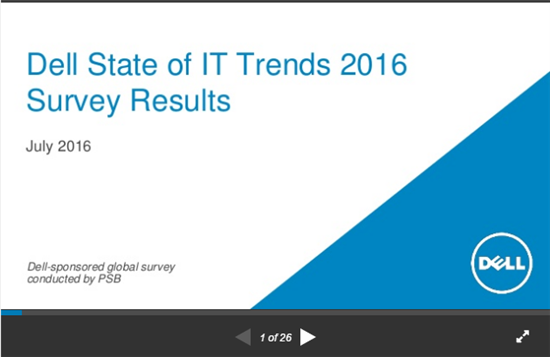In my conversations with customers through the years, I have seen how their perceptions, attitudes and understanding of new technologies have changed over time. The rise of digital transformation and associated technologies has changed IT systems across just about every industry. And there’s no debate—IT is clearly a key partner and an enabler for accelerating growth and uncovering new avenues for business opportunities.
As key technologies and delivery mechanisms continue to evolve, one thing that has remained constant is the increasing interest of leveraging technology by business leaders to drive growth and create competitive differentiation. However, it also has been widely reported that a gap in understanding between IT leaders and business leaders has opened up throughout this period of business and technology disruption. Our latest study, however, suggests that this gap has closed significantly.
Dell commissioned a Dell State of IT Trends 2016 global study to understand how business and IT leaders’ perceptions of technology have evolved as new technologies and delivery methods have entered the market. We wanted to understand these leaders’ point-of-view on key IT trends including compute-centric, software-defined data center, openness, cloud, data center management and digital transformation. You can view the survey results here:
While the original intent of this survey was not to specifically focus on the similarities and differences between IT and business decision makers, we found that there is an increasingly common understanding between the two groups, and more than perhaps it’s generally perceived to be. The results indicate that IT and business leadership are better collaborating on the same page about the latest in IT and how it can propel businesses forward. While I’ve seen firsthand the gap of technology know-how between business and IT decision makers close over the past several years, this Dell study shines a bright light on this trend.
According to the Dell State of IT Trends 2016 global study, here are example areas where business decision makers (BDMs) and IT decision makers (ITDMs) are most closely aligned:
- Increasing business productivity is the main IT consideration for both ITDMs (81 percent) and BDMs (77 percent), followed by growing the business (71 percent and 69 percent, respectively).
- ITDMs (62 percent) and BDMs (51 percent) agree that cloud computing is the most important technology trend for their companies.
- The ability to burst to public cloud as needed is important to both ITDMs (83 percent) and BDMs (74 percent)
- In terms of technology spending for 2016, cloud is the main priority among both ITDMs (67 percent) and BDMs (59 percent).
- Eighty-eight percent of ITDMs and 80 percent of BDMs say their organization is considering adopting a software-defined data center (SDDC), is in the process of transitioning, or has already completed the transition to one.
- Both groups agree the benefits of SDDC are flexibility, simplicity, efficiency and cost-savings, although ITDMs also place a greater value on increased scalability (57 percent) than BDMs (40 percent).
- By a 2:1 margin, both ITDMs and BDMs believe they will use more open data center technologies in the future.
- Eighty-six percent of ITDMs and 85 percent of BDMs agree that compute-centric is the best approach to gain a flexible, scalable and open data center.
As we have heard repeatedly through the years, business success is increasingly predicated on strong teamwork between business leaders and IT leaders. While we are not fully through this latest round of disruption, the results of this study suggest that we are moving out of the early stages where friction gives way to greater collaboration and improved performance. The study reveals significant validation on the adoption rates of key industry trends. Additionally, we’ve confirmed that business and IT leaders are more clearly aligned than you might have thought. Much like the Tuckman Teaming Model, which describes teams that Form, Storm, Norm, and Perform, these times of significant disruption to the status quo force us all to go through this process again. It feels like we are well out of the storming phase, well through the norming phase, and can enjoy the fruits of that process by hitting our performing stride.
On behalf of Dell, research firm PSB conducted an online survey of 1,200 global customers on key IT trends in April and May 2016. The survey included 701 IT decision makers and 500 business decision makers from small businesses to large enterprises in seven developed and developing countries around the world.
To review the rest of the survey results, check out our news release.

